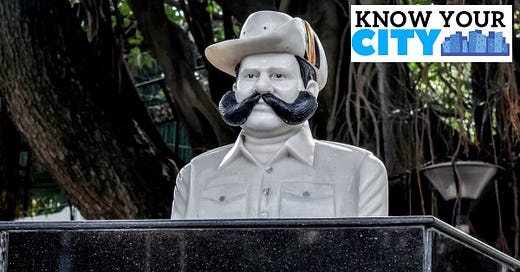The legend of Meese Thimmaiah, and more | #258
+ did you know Bhiku Mhatre was a Spielberg stan?
Friends,
The Indian Police system traces its roots to 1776 when the Indian Army was formed under the East India Company in Kolkata. The formal police structure emerged after the 1857 rebellion with the Indian Police Act of 1861, designed to prevent future uprisings.
This week, apropos of nothing, we take a look at some interesting stories about the Indian Police.
Things we learnt this week 🤓
Lawrence Bishnoi is a notorious gangster, who’s infamy stems from threatening Salman Khan over his involvement in the blackbuck case. He was also allegedly behind the murder of Sidhu Moosewala. Ironically for a man on the wrong side of the law, he took his nom de guerre after the guy who introduced the Indian Police uniform!
Sir Henry Lawrence was the British Governor-General's agent, who noticed an officer wearing this dust-colored uniform and recognized its practical advantages. The word "khaki" comes from the Persian word "khak," meaning dust - a fitting name for a uniform designed to hide dirt in India's challenging climate. What makes this even more remarkable is that the khaki dye was actually invented in India by John Haller, a German textile engineer working in Mangaluru (Karnataka), who created it using oil extracted from cashew shells. Lawrence Bishnoi might not respect the Khaki, but he is quite the stain on the law!
When the British ordered all police forces to adopt khaki in 1847, the Kolkata Police successfully refused the change with a compelling argument: given the city's extreme heat and humidity, white uniforms were more practical and comfortable for officers. This tradition continues today, making Kolkata Police easily distinguishable from other Indian police forces across the country. The British administration specifically chose white for Kolkata's police due to the city's coastal location, where high heat and humidity levels made white scientifically superior as it reflects sunlight and heat rather than absorbing it. Amar Whiter Bangla.
If you’re ever in Bangalore try and spot this statue which has an interesting story behind it:
This is the bust of one Meese Thimmaiah - a legendary figure in the Bangalore Traffic Police circles. Born as Marichikaiah Thimmaiah he joined the Bengaluru Traffic Police in 1977. What made him instantly recognizable was his magnificent handlebar mustache, which earned him the nickname "Meese" (mustache in Kannada) Thimmaiah. His dedication to duty was so legendary that the police department made a special exception for him - providing an annual allowance of ₹500 specifically for maintaining his impressive mustache. In fact, schoolkids would cheer for him from their buses, and he became a beloved figure for both locals and visitors. His popularity was so immense that despite mandatory routine transfers, the department never changed his posting location. On August 26, 1995, Thimmaiah made the ultimate sacrifice while on duty. When a speeding vehicle ignored his signal to stop, he rushed to save a woman and her child from being run over. In this heroic act, he was struck by the vehicle and lost his life. In tribute to his memory, the junction was fittingly renamed as "Police Thimmaiah Circle" after his tragic death - a symbol of duty and service.
From IWTK, with love 💌
Have you seen the classic film Jijamata Park? Check out this legendary scene here.
Americans believe without them the world would be speaking German.
Only In India 🇮🇳
This particular species is called a Bua Constrictor
💟 IWTK










